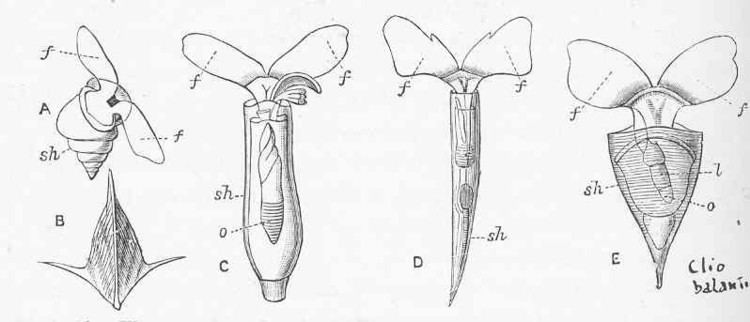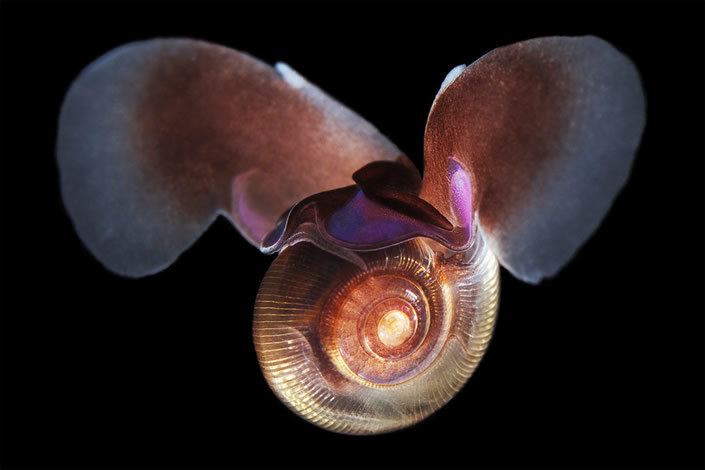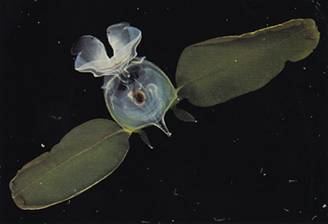Clade Heterobranchia Informal group Pteropoda | ||
 | ||
Representative species Clione limacina, Limacina helicina, Paedoclione doliiformis, Thalassopterus zancleus | ||
Pteropoda diversity
Pteropoda (common name pteropods, from the Greek meaning "wing-foot") are specialized free-swimming pelagic sea snails and sea slugs, marine opisthobranch gastropods. The monophyly of Pteropoda is the subject of a lengthy debate; they have even been considered as paraphyletic with respect to cephalopods. Current consensus, guided by molecular studies, leans towards interpreting the group as monophyletic.
Contents
- Pteropoda diversity
- Pteropoda opistobranch sea angels from the sonoma coast stillwater california
- Taxonomy
- Resistance to ocean acidification
- References

Pteropoda encompasses the two clades Thecosomata, the sea butterflies, and Gymnosomata, the sea angels. The Thecosomata (lit. "case-body") have a shell, while the Gymnosomata ("naked body") do not. The two clades may or may not be sister taxa; if not, their similarity (in that they are both pelagic, small, and transparent, and both groups swim using wing-like flaps (parapodia) which protrude from their bodies) may reflect adaptation to their particular lifestyle.

Pteropoda opistobranch sea angels from the sonoma coast stillwater california
Taxonomy

The group Pteropoda was established by Georges Cuvier as "ptéropodes" in 1804. François Péron and Charles Alexandre Lesueur thought the group to be larger, and so they also included the opisthobranch taxa (Phyllirhoë and Glaucus), the heteropoda taxa (Carinaria and Firola), and even the Ctenophora (Callianira). In 1810 these authors divided the whole group in two separate groups: those with a shell and those without a shell.

In 1824 Henri Marie Ducrotay de Blainville named these two groups Gymnosomata and Thecosomata and named the combining order Aporobranchia instead of Pteropoda. He rejected the additional genera, except Phyllirhoë which he upgraded to a third group that he called Psilosomata. Only much later was Phyllirhoë classified within the order Nudibranchia.

Other attempts were made to describe the Pteropoda. John Edward Gray divided the Pteropoda into Dactylobranchia (with just the genus Cavolinia) and Pterobranchia (including all the other genera). Cuvier (and his followers) did not accept the classification by de Blainville; they preferred the original classification as described in Le Règne Animal.

In 1829 Paul Rang followed the Cuvierian classification, but tried to include the character of having a distinct head or not. The German naturalist Lorenz Oken went one step further and, for the sake of symmetry, wanted each order to contain four families and each family to contain four genera. Pierre André Latreille divided the Pteropoda according to the size of their fins: "Macroptérygiens" (including only Pneumonoderma) and "Microptérygiens" (including all the others). In 1851 William Bullock Clark treated the Pteropoda as a family and emended the spelling to Pteropodidae (a name now used for a family of fruit bats)
Finally all these attempts were abandoned and, as more and more species were described as a result of several scientific expeditions, the classification of the Pteropoda into Thecosomata and Gymnosomata was generally adopted. Many of these new species were first described by French zoologists, for example Jean René Constant Quoy and Joseph Paul Gaimard, Paul Rang, Alcide d'Orbigny and Louis François Auguste Souleyet.
The relationship between these two clades is not unequivocally established, but it seems that they are sister taxa.
Resistance to ocean acidification
A study was conducted on the West Coast of the United States to see ocean acidification’s effects on pteropods. Limacina helicina was used to test the sensitivity to decreasing pH. The shell of a pteropod was immersed in ocean water with the projected pH level that the water will reach by the year 2100. After a month and a half in the water, the shell had almost completely dissolved.
